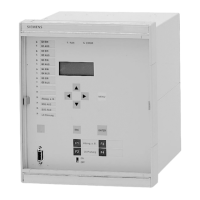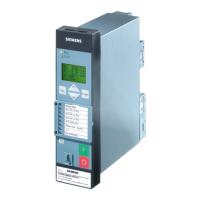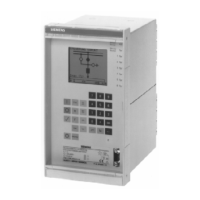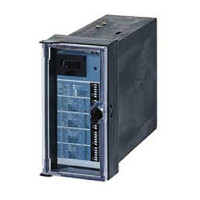' $ ! $!& #$"&&"! Ċ (%& !' $$ !"
5 - 22
Siemens AG ⋅ January 1999
The required function is confirmed with the enter key
E. Additional functions (under further index numbers)
can then be selected for the same physical module
using the B key. Each selection must be confirmed
with the E key. If the particular input of a physical moĆ
dule is not assigned, the "not all." function (not
allocated) is selected.
To exit the selection level, press A. The previous opeĆ
rating level appears on the display. You can now
switch to the next physical input/output module by
pressing the B key or to the previous module with
theY key where you can then proceed as before.
The following sections specify the marshalling for the
binary inputs, binary outputs and displays. The arrow
keysB Y or "Anext to the display boxes indicate
the method of scrolling from operating level to operaĆ
ting level as well as within the block or selection leĆ
vel. The arrow keys which lead to the next operating
object in accordance with the logical sequence of the
marshalling process are indicated in bold Figures.
You will find full details of the available function deĆ
signations in appendix C. If operation is carried out via
a PC and the operating program DIGSI
R
, each setting
parameter is identified by a 4-digit address number.
In the following Figures this is shown in brackets next
to the explanations.
If you attempt to scroll on without confirming a marsĆ
halling with the enter key E , the following prompt will
appear: "Change parameter ?". Confirm with the
"Yes" key J/Y to confirm and apply the new setting.
The new text is displayed. However, if you press the
"No" key N, the change entered since the E key was
last pressed is canceled and the old text is displayed.
This enables you to cancel any erroneous changes. To
continue to scroll forward, you must now press the
relevant arrow key again.
When the marshalling is terminated by pressing the
enter key E the allocations are immediately applied
and permanently saved and protected against power
failure in EEPROMs.
5.5.2 Marshalling of the binary inputs
- block 61
The device has 3 binary inputs which are designated
BI 1 to BI 3. They can be marshalled in block 61. You
can reach the block from the initial state of the device
in level 1 as follows: Press the B key (forwards),
switch to the 2nd operating level with the " key
(next level), scroll with the B key until block 60 apĆ
pears on the display. Use the " key to switch to opeĆ
rating level 3 !: Marshalling binary inputs, see Figure
5.11).
Selection is carried out as described in section 5.5.1.
A choice is available for each binary input function as
to whether the activated voltage is applied, or wheĆ
ther it is removed, whereby:
D ( ) activated with voltage:
The input acts corresponding to a make contact,
i.e. the control voltage at the input terminals actiĆ
vates the function;
D (C) activated with voltage reset:
The input acts as a break contact, i.e. the control
voltage at the input terminals resets the function.
If there is no control voltage, the function is active.
When scrolling with the "+" or "-" key, each input
function is displayed either without a status indication
(activated with voltage) or with the status indication
"R" (activated with voltage reset). The selected funcĆ
tion must be confirmed with the enter key E.
Table 5.1 shows a list of all the input functions with
their respective function numbers Fno. Input funcĆ
tions have no effect if the relevant protective function
of the device has been configured so that it is not
available (see section 5.4.2).
The general diagrams in appendix A show the assignĆ
ment of the binary inputs on delivery. The following
boxes show an example assignment for binary input
1. Table 5.2 shows all presettings.
